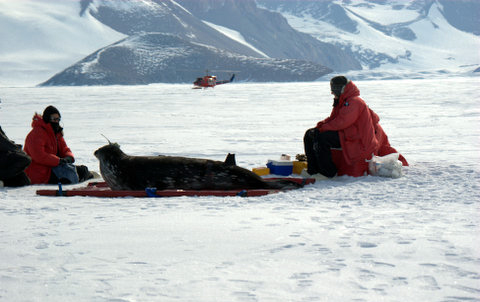|
Motion captureScientists track seals through winter to learn about ecology and oceanographyPosted September 28, 2012
It’s been about 20 years since anyone attempted to follow Weddell seals through the Antarctic winter. But a multidisciplinary team of scientists is using the latest in satellite tag technology to track the movements of the world’s most southerly mammals over the dark and cold months. “Historically, that’s been a big black box for seal behavior and ecology,” said Jennifer Burns However, the project seeks not only to learn more about the animals but the ocean environment in which they swim. The small instruments that the seals carry on top of their heads also record ocean properties, such as temperature and salinity, in addition to tracking their dive profiles and location. “The cool thing about the animal is that they’re not stopped by sea ice. They can go into areas where [ships don’t] have any chance of getting in, particularly the areas up near land,” noted Eileen Hofmann Weddell seals (Leptonychotes weddellii) are one of the top predators in the Antarctic, with a circumpolar range throughout the Southern Ocean. During the summer, they favor coastal habitats, making use of the fast ice, or sea ice that’s frozen along the shore. In the winter, researchers believe they increase their use of the floating pack ice farther from the coast to forage for food such as sardine-sized silverfish (Pleuragramma antarcticum). The seals’ reliance on sea ice makes them vulnerable if changes in climate alter their habitats. Also, natural perturbations, such as the large iceberg that chocked McMurdo Sound in the early 2000s and locked in the sea ice, could also affect their ability to successfully breed and forage. Understanding the animals’ behavior and physical habitat will help scientists predict how the Weddell seals will fare in the future. Toward the end of the austral summer for the last three years, Burns, co-principal investigator Daniel Costa Their job is to locate about 20 seals each year to outfit with the electronic data loggers, which transmit their data on seal diving behavior and water column properties via satellites every time an animal emerges from the water. And, every time the tag transmits, the physical location of the seal can be estimated, providing a track of their movements throughout the Ross Sea “Tags are also archiving all of the information that they’re collecting. They’re little mini computers,” Burns said during an interview at the Scientific Committee on Antarctic Research (SCAR) About five or six times more information, according to Burns, so recovering the instruments at the beginning of each austral summer in October and November has become quite important. Apparently, the tags, particularly the antennas, take quite a beating over the winter, so the data don’t always flow over the satellites. “We actually saw one animal come out of the water with our tag on and just proceed to bash into the ice several times,” said Kim Goetz |



For USAP Participants |
For The Public |
For Researchers and EducatorsContact UsU.S. National Science FoundationOffice of Polar Programs Geosciences Directorate 2415 Eisenhower Avenue, Suite W7100 Alexandria, VA 22314 Sign up for the NSF Office of Polar Programs newsletter and events. Feedback Form |



